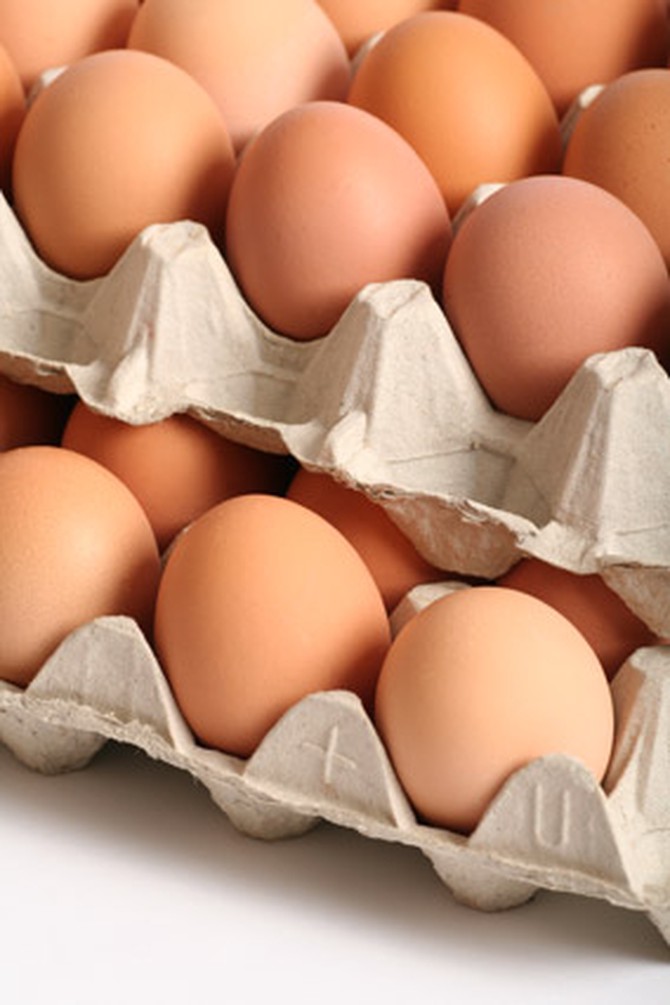Grocery Aisle Smackdown: What's Worth It, What's Not
Should you buy cage-free or organic eggs? Lobster or a so-called cheaper alternative? We find out where to spend and where to save.
By Lynn Andriani

Photo: Thinkstock
Mayonnaise: Olive Oil vs. Regular
Our choice: Olive oil
Why: Even though mayo made with olive oil (such as Hellmann's Mayonnaise Dressing with Olive Oil) still contains some soybean oil, which is the primary oil in most regular mayos, it has about 40 percent less fat and calories than the standard spread. It's a nice compromise between full-fat and light mayo, which has about half the fat and calories of the olive oil version—but tastes like it.
The only drawback: Some may notice a difference in taste (the olive oil adds a slight tang).
Why: Even though mayo made with olive oil (such as Hellmann's Mayonnaise Dressing with Olive Oil) still contains some soybean oil, which is the primary oil in most regular mayos, it has about 40 percent less fat and calories than the standard spread. It's a nice compromise between full-fat and light mayo, which has about half the fat and calories of the olive oil version—but tastes like it.
The only drawback: Some may notice a difference in taste (the olive oil adds a slight tang).

Photo: Thinkstock
Lobster vs. Monkfish
Our choice: Lobster
Why: Once upon a time, lobster was a luxury item, something you'd eat on a special occasion at the height of summer. Monkfish, often dubbed the poor man's lobster, was considered a middling alternative. These days, though, the Maine lobster population has exploded, with lobstermen hauling in record numbers. The result: rock-bottom prices. You'll pay about $12 a pound for lobster right now versus $15 a pound for monkfish.
The only drawback: None (for consumers), unless you consider OD'ing on lobster rolls a problem.
Why: Once upon a time, lobster was a luxury item, something you'd eat on a special occasion at the height of summer. Monkfish, often dubbed the poor man's lobster, was considered a middling alternative. These days, though, the Maine lobster population has exploded, with lobstermen hauling in record numbers. The result: rock-bottom prices. You'll pay about $12 a pound for lobster right now versus $15 a pound for monkfish.
The only drawback: None (for consumers), unless you consider OD'ing on lobster rolls a problem.

Photo: Thinkstock
Eggs: Cage-Free vs. Organic
Our choice: Organic
Why: Organic eggs are produced by hens given feed grown without most conventional pesticides, fungicides, herbicides or commercial fertilizers; standards also prohibit the use of growth hormones. The American Egg Board says eggs labeled simply "cage-free" usually come from hens living on the floor of a barn or poultry house. Their mortality rates are higher, since the birds tend to peck at and injure each other. Plus, the nutrient content of eggs from cage-free hens is the same as for those produced by hens housed in cages.
The only drawback: Cost. It varies depending on where you live, but organic eggs run at least a dollar more per dozen.
Why: Organic eggs are produced by hens given feed grown without most conventional pesticides, fungicides, herbicides or commercial fertilizers; standards also prohibit the use of growth hormones. The American Egg Board says eggs labeled simply "cage-free" usually come from hens living on the floor of a barn or poultry house. Their mortality rates are higher, since the birds tend to peck at and injure each other. Plus, the nutrient content of eggs from cage-free hens is the same as for those produced by hens housed in cages.
The only drawback: Cost. It varies depending on where you live, but organic eggs run at least a dollar more per dozen.

Photo: Thinkstock
Vegetables: Precut in a Microwavable Bag vs. DIY
Our choice: DIY
Why: We knew the convenience of neatly chopped vegetables in microwave-ready bags came at a price, but we were surprised to see just how much the extra help costs: 99 cents for a regular bag of carrots versus $3.99 for a ready-to-cook package.
The only drawback: More time in the kitchen. It takes about three minutes longer to peel and slice carrots yourself, put them in a bowl, cover it with a lid and put it in the microwave.
Why: We knew the convenience of neatly chopped vegetables in microwave-ready bags came at a price, but we were surprised to see just how much the extra help costs: 99 cents for a regular bag of carrots versus $3.99 for a ready-to-cook package.
The only drawback: More time in the kitchen. It takes about three minutes longer to peel and slice carrots yourself, put them in a bowl, cover it with a lid and put it in the microwave.

Photo: Thinkstock
Strawberries: Fresh vs. Frozen
Our choice: Frozen
Why: It's worth noting that you're better off buying organic strawberries (here's scientific evidence that they taste better than conventionally grown ones). The problem is that fresh organic berries can cost $6 for a 16-ounce package. However, frozen are 25 percent less (we found a 10-ounce bag for just $2.79). They're great in smoothies and daiquiris, or you can defrost them to toss into oatmeal.
The only drawback: Limited use. You can't put them in strawberry shortcake or a fruit tart, since they'll be soggy when they defrost.
Why: It's worth noting that you're better off buying organic strawberries (here's scientific evidence that they taste better than conventionally grown ones). The problem is that fresh organic berries can cost $6 for a 16-ounce package. However, frozen are 25 percent less (we found a 10-ounce bag for just $2.79). They're great in smoothies and daiquiris, or you can defrost them to toss into oatmeal.
The only drawback: Limited use. You can't put them in strawberry shortcake or a fruit tart, since they'll be soggy when they defrost.

Photo: Thinkstock
Tea: Loose vs. Bagged
Our choice: Loose
Why: Most tea bags contain small pieces of broken leaves, while loose teas consist of whole leaves (or at least large pieces), which tend to deliver superior flavor, says Sarah Segal of DavidsTea, which has locations throughout Canada and in New York City. And although tea bags may come in a plastic-sealed box, once you open it and leave it in your cupboard for a year, the tea quickly deteriorates. Finally, there's much greater variety with loose tea (you're often limited to black or green tea in bags).
The only drawback: Inconvenience. It can be hard to tote loose tea to work, for instance. Try tea filters: These little pouches from DavidsTea are biodegradable and chlorine-free; just scoop in your tea, pull the drawstring tight and pour hot water over the bag.
Why: Most tea bags contain small pieces of broken leaves, while loose teas consist of whole leaves (or at least large pieces), which tend to deliver superior flavor, says Sarah Segal of DavidsTea, which has locations throughout Canada and in New York City. And although tea bags may come in a plastic-sealed box, once you open it and leave it in your cupboard for a year, the tea quickly deteriorates. Finally, there's much greater variety with loose tea (you're often limited to black or green tea in bags).
The only drawback: Inconvenience. It can be hard to tote loose tea to work, for instance. Try tea filters: These little pouches from DavidsTea are biodegradable and chlorine-free; just scoop in your tea, pull the drawstring tight and pour hot water over the bag.

Photo: Thinkstock
Yogurt: Regular vs. Greek
Our choice: Greek
Why: It's creamier, tangier, less sweet and has more than double the protein of the conventional version, thanks to the straining process.
The only drawback: Cost. The Greek version can go for more than double the price of regular yogurt. You can get around this by making your own, as this video shows, using ordinary kitchen utensils.
Next: Store-bought shortcuts—what's worth it, what's not
Why: It's creamier, tangier, less sweet and has more than double the protein of the conventional version, thanks to the straining process.
The only drawback: Cost. The Greek version can go for more than double the price of regular yogurt. You can get around this by making your own, as this video shows, using ordinary kitchen utensils.
Next: Store-bought shortcuts—what's worth it, what's not
Published 07/08/2012

